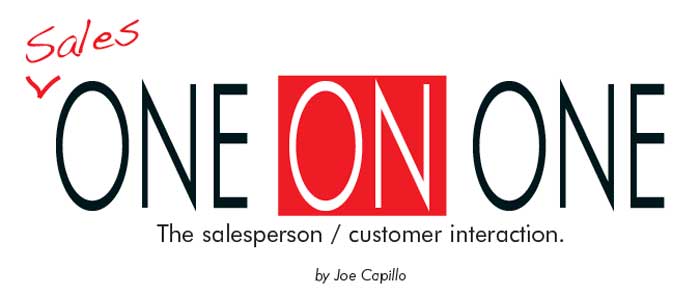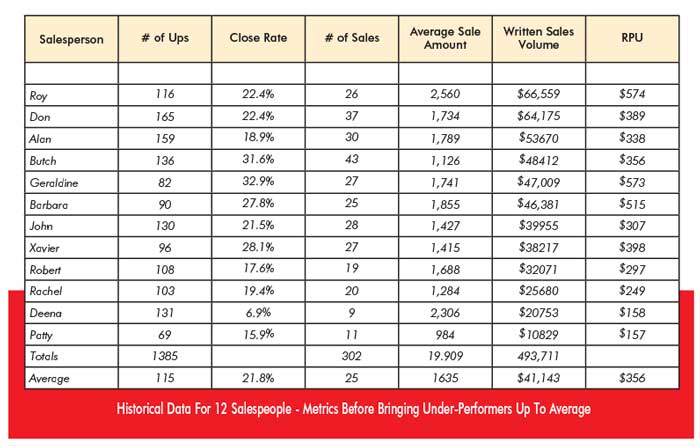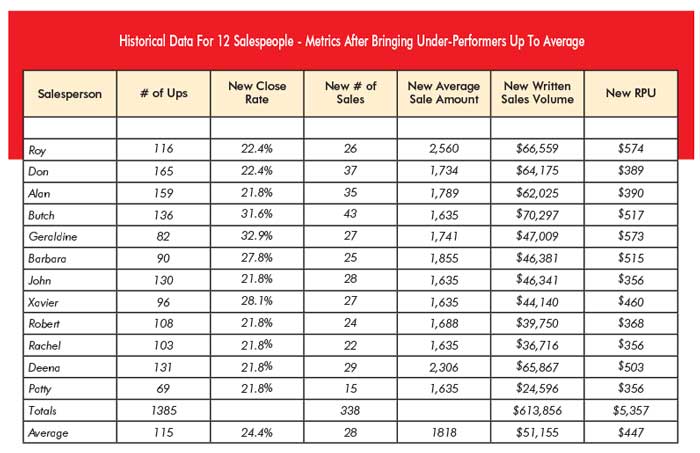
The strategic view
There are thousands of sales managers who spend too much time teaching salespeople how to do things right, rather than how to do the right things. The missing link is clear: there is hardly ever a clearly written, well taught-out and coached selling strategy, also known as a Customer Engagement Strategy, that establishes the basis for all sales training, coaching, and execution.
For a customer engagement strategy to be successful, your salespeople have to buy in to your processes. If you have, for example, 10 salespeople on staff, and each has a different selling strategy, it makes the role of sales manager almost impossible to perform. Certainly, you will have 10 diverse skill-sets, but problems will inevitably arise from the fact that:
- Each salesperson will deliver a different customer experience.
- Each salesperson will have their own winning formula he or she believes is better than their co-workers, and also better than the sales manager’s stated engagement strategy (if any).
- Sales goal setting and sales coaching will be less effective.
This points to the need to develop and follow a comprehensive selling system that incorporates the following three elements:
- Have a strategy – written, known and followed by everyone.
- Get the metrics – live in the numbers. Use BABTA thinking: Below Average Brought to Average.
- Use the salespeople’s goals – they’ll get you to your goals.
Dealing with the Metrics
On my first day in the furniture industry as an Ethan Allen store manager for an independent owner in Norwalk, CT, I was told by Nathan Ancel, then the owner and Chairman of Ethan Allen, that I had two things to worry about – Close Ratio and Average Sale. “We’ll take care of the rest” he said. They did, and this piece of wisdom is as true today for furniture retailers as it was back then.
Below is an example of real store performance data (metrics), the kind that should guide sales management. In the first chart are the results of 1,385 customer engagements over a one month period. Salespeople are ranked by their Average Sale value. The second chart shows what the results would have been if those people who performed below average in Close Ratio and/or Average Sale had performed at the average level for the team in each metric.

The first chart shows historical data for 12 salespeople. The second chart answers the Sales Manager’s question, “what if” we set a goal and devote resources to bring under-performing sales associates up to the average for the group?
The answer in this example is a more than 24% increase in both Sales and Revenue Per Up. The best news is that to achieve this increase in sales, no additional customers or advertising dollars need be added. Fixed expenses don’t go up (your variable expenses do), and your profits go up as well. The even better news is that this increase in sales revenue for a typical retail furniture store will more than double profits!

It’s a simple process that’s been the foundation of my efforts over the years. It never fails to generate an environment of continual improvement, because once you reach the new, higher levels of performance, you do the whole thing over again, and again.
Focus on Earnings
As overall store performance improves, so do the earnings of many salespeople who had been performing below the averages. This is the driving force behind sales management initiatives that work. Sales managers should focus on increasing each salesperson’s earnings, set goals and coach to get them there.
In addition to the obvious affect sales improvement has on sales manager and company success, this strategy promotes teamwork, overall positive morale, and personal success for all individuals.
So far this article has focused on under-performing people, but it’s just as important to hold on to your high earners. This requires that you focus on getting every member of your sales team to their goals instead of just concentrating on your company’s goals. You don’t want to lose your best earners to competitors due to lack of sales management support.
Managing Your Range of Performance
What causes some salespeople to consistently have the highest Closing Ratio, or the highest Average Sale? The answer is two-fold:
1. These people have personal skills that help them to connect to their customers – right from the start.
2. They have learned about how the products they sell are made, as well as features that will resonate with consumers as benefits (remembering always that there are no benefits that lie outside a customer’s need for them)
3. They possess some or all of the following selling skills:
- Connecting skills – includes everything from the way they look, smile, what they say, and how they say it. This helps them to connect rapidly to other people without appearing “pushy”.
- Interview skills – to determine why each customer is in your store. They learn about the customer’s “project” (because it’s always a project to them) – and what their customer wants to accomplish today. Understanding the customer’s “project” is a critical element because the decision to buy will almost always have ramifications beyond just today’s purchase.
- The knowledge that few customers buy on their first store visit – on a “project”. My metrics history shows that around 15% of first-time visitors on a new project purchase on their first visit, BUT, that number goes up to 70% or higher on a second visit. Most stores’ overall close ratio is a combination of first-time buyers and Be-Back buyers who are in the store for the second or third time on a “project”. This means that the real goal of dealing with a customer on a first visit should often be to get a second visit. To do this effectively requires a robust CRM plan and system to capture contact information from each non-buyer. Getting customer information is easier when a high-level connection between salesperson and customer is established. And, this type of connection is best based on trust and the understanding that the salesperson truly understands the customer’s situation (project) and is willing to help her achieve her goal.
If you want to help your salespeople achieve higher Close Ratio and Be-Backs, have them record every customer opportunity. Make sure they note those customers who fit the description of a Be-Back – someone who has been in the store before on the same project.

Previous customers who return to the store (and hopefully to the salesperson) on a new home furnishings project are considered to be “Personal Trade”, and the best salespeople accrue a lot of them over time. Track them all, and know your metrics. When these people return, they buy because trust has already been established (if you’ve done everything well) and they know you know about their projects.
“Sales” Training
There are many kinds of training that retail furniture salespeople need to receive. Usually it begins with product knowledge encompassing literally thousands of details. There are many ways to manufacture furniture, and most vendors use many different manufacturing processes and components to build their products. It’s important for salespeople to know about them all, and to be able to relate the information to customers.
From good old solid wood to Medium Density Fiberboard (MDF) and from Eight-Way Hand Tied spring decks to sinuous wire systems, they must know it all, and be able to explain it to their customers in terms that don’t denigrate anything, but explain the benefits. Your salespeople must be experts on everything they sell, and where each item fits on the scale of quality and value in our industry.
Sales managers should conduct regular training sessions on these topics, and this is the perfect place to have manufacturer’s sales representatives explain all the details salespeople should know.
In my thinking, this is the ONLY place where manufacturer’s sales reps should engage salespeople... under the careful monitoring of the sales manager.
“Selling” Training
After understanding what they’re selling, salespeople move to the front line which is engaging customers who are wary of anyone with the title “Sales Associate”. The decision-making process has five levels of progression, so knowing where a customer is on this progression is important. Managers should make sure that every salesperson understands, and is on the lookout for, these five different stages of decision–making which are:
- Dreaming – which can last years months or minutes.
- Exploring – this is where connection is critical. Interpersonal skills reign supreme.
- Planning - this is where understanding and connecting to the project are key
- Selection – this is where you want to be every time.
Enjoyment – and here too, staying involved after the delivery is a career-building exercise.
We usually meet people in one of the four stages after the Dreaming stage, but there is no research available regarding how long any of these stages lasts, or what the interval timing is between them. In today’s hyper-connected world, customers can move from dreaming to selection with just a few clicks of a smart phone. The Exploring, Planning, and Selection stages are likely to be all happening at the same time in many cases – which is the definition of confusion and uncertainty that is summed up in a salesperson’s description of her last customer - “She doesn’t know what she wants.”
My point is that if you can connect to a person in the Exploring or Planning stages – you can be around for the selection stage – which is when sales are closed.
All of these issues are subjects for Sales and Selling Training. You need a program and a system that your salespeople understand, respect, and use to be great in the one most important area of performance improvement – bringing back the non-buyers!
Now, let’s say you have your selling strategy in place; the metrics you need; have established your salespeople’s goals for income; and the training is in place to deliver your strategy. What’s next?
Observe the Game Being Played
Imagine a professional football game being played while the head coach is in his office planning the next game, or making travel arrangements to next week’s game, or going over the stats from last week’s game. Sounds just plain dumb, right? All the coaches, the head coach, the offensive coach (coordinator), the defensive coach, the receivers coach, are all watching the game being played, play-by-play. There are dozens of other observers as well who watch individual players, record the action and feed information in real time to field coaches who use this information to make immediate changes on the field of play.
You have a game being played in your stores every day, but where are you? In most stores no one observes the game being played, and that’s why managers are sometimes surprised by the results, good or bad.
Observation is one of the key elements in sales management that is sadly ignored by furniture store owners and managers. Observation shows you quickly whether your selling strategy and training have had an effect on behavior. It’s called execution, and failure to execute is the single common point-of-failure in our business. We are playing a one-on-one game between one salesperson and one customer (or family). If you only pay attention to the end result, how will you know what coaching advice you need to provide to each individual salesperson? Metrics alone won’t tell you the whole story. You have to hear the words, the body language and evaluate the chemistry.
Of course, you can’t observe every interaction, so create a way for each salesperson to document his or her customer engagements in an unobtrusive way. It should include information such as:
- A summary of the project.
- A sketch of the room.
- What’s being replaced, added, or is staying in the room.
- What the time-line is for completion.
- What products are being considered now with pricing and stock status.
- What is the follow up plan by date – when to contact, etc.
A document should be used to evaluate the salesperson’s work as well as feed your CRM system so you can remain in contact with customers regarding unresolved projects to draw them back. If they did buy, this can be used by salespeople to invite customers to the next 100 sales events to get their next projects going.
Provide Positive Feedback
Watch the game being played. Listen and note how the interaction progresses. If you get personally involved in the play, as a manager, the customer’s focus will switch to you. Take every opportunity to support your salespeople. If you feel that it’s necessary to intervene with a customer during an observation session, be supportive, agree with their inputs, and simply add something new if you see the need. Never, ever make them appear weak or unknowledgeable. Use your intervention as an opportunity to teach by example.
If you just observe or teach by example, feedback after every observed engagement is necessary. Meet with your salesperson immediately after the customer leaves the store. Feedback has to be provided quickly and be based on your personal observations as they relate to the facts of a specific situation and how it relates to your Selling Strategy. There will always be a lot of good things done right and well. Make sure these points have equal emphasis with the points that are not so great.
Always, always remember that no one wants to do a bad job. No one wants to go to work every day and fail, yet closing ratios in the 20% to 25% range means salespeople fail 75% to 80% of the time. Never forget this as a coach.
In major league Baseball a lifetime batting average of 250 gets you early retirement. A lifetime average of 300 gets you into the Hall of Fame. In your business, the difference between a store closing rate of two out of every ten customers (losing eight out of 10), and closing three out of every ten (still losing seven of 10) is a 50% increase in sales. Can your team do it?
Observation of the game being played, the work being done, puts you in the game with your people. When you’re out there with them, they’ll remember their training, try to do things right, not take shortcuts.
Individual Coaching
Weekly planned and scheduled one-on-one coaching meetings are a must as well. Your top performers deserve your personal congratulations. Weak salespeople need the same thing if they are improving. If they’re not improving, don’t be angry, don’t resort to the three principles weak, ineffective leaders resort to: threats, intimidation, and fear. Remember – no one wants to do a poor job at their job.
Review the things you have observed and offer direct advice on how to do better. Don’t just tell a person, “You have to do better.” Tell them how, and when you can, show them how by letting them observe you doing it right with real customers.
Develop a Performance Improvement Plan for everyone who is performing below the 90-day averages for Close Ratio and/or Average Sale. Have the current update ready for this coaching meeting, and go over the details carefully and thoughtfully with a positive, “you can do this…” attitude. Never, never get angry. Remember, you are not dealing with children.
Then, there’s this: Everyone contributes to the total, whether they are below the “averages” or above them. All contributions are important and meaningful to your company regardless of what didn’t happen or might have been. Thank each person, and find additional ways to teach, support, and guide those who need it. That is leadership.
Team Sales Meetings
Team sales meetings are important for many reasons:
- First, congratulate the team when it wins.
- Congratulate individuals who have performed well or outstandingly.
- Congratulate those who have improved since the last meeting.
- Offer information from other departments such as Merchandising, Warehouse, Service, Delivery and Advertising.
- Owners can weigh in, but always in a way that is positive and supportive. After all, it’s the result of work by salespeople that pays for all those other departments.
- Group sales meetings should be held early in the day, prior to opening for the day.
Conclusion
So, there you have it all:
- You have your selling strategy in place.
- You have the metrics you need.
- You have your salespeoples’ goals for income.
- You have training in place to deliver your strategy.
- You have coaching tools in place.
- You are observing your salespeople in action.
- You are providing positive feedback.
- You are holding one-on-one sales meetings.
- You are holding staff sales meetings.
And the coaching cycle just continues, utilizing individual Performance Improvement Plans to guide your coaching efforts.
When things change, as they always do, you’ll adjust your selling strategy and training. Remember that your strategy must always address the ways people think about their homes, their lives and their shopping preferences today.
Joe Capillo is a 41 year career veteran, experienced in managing and consulting with furniture retail operations. He is also a contributing editor for Furniture World Magazine. He is a contributing editor to FURNITURE WORLD and a frequent speaker at industry functions. See all of Joe’s articles on the furninfo.com website.